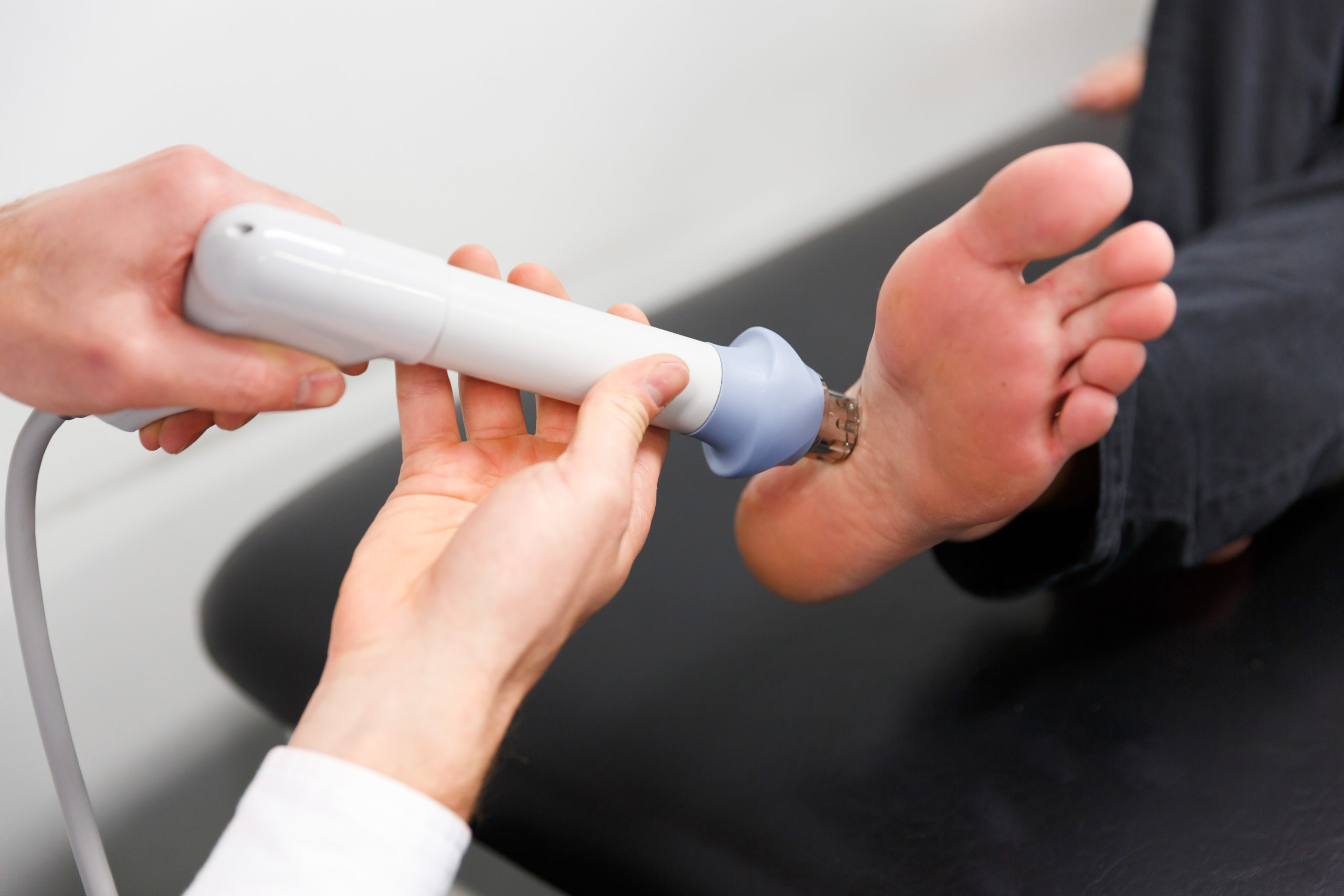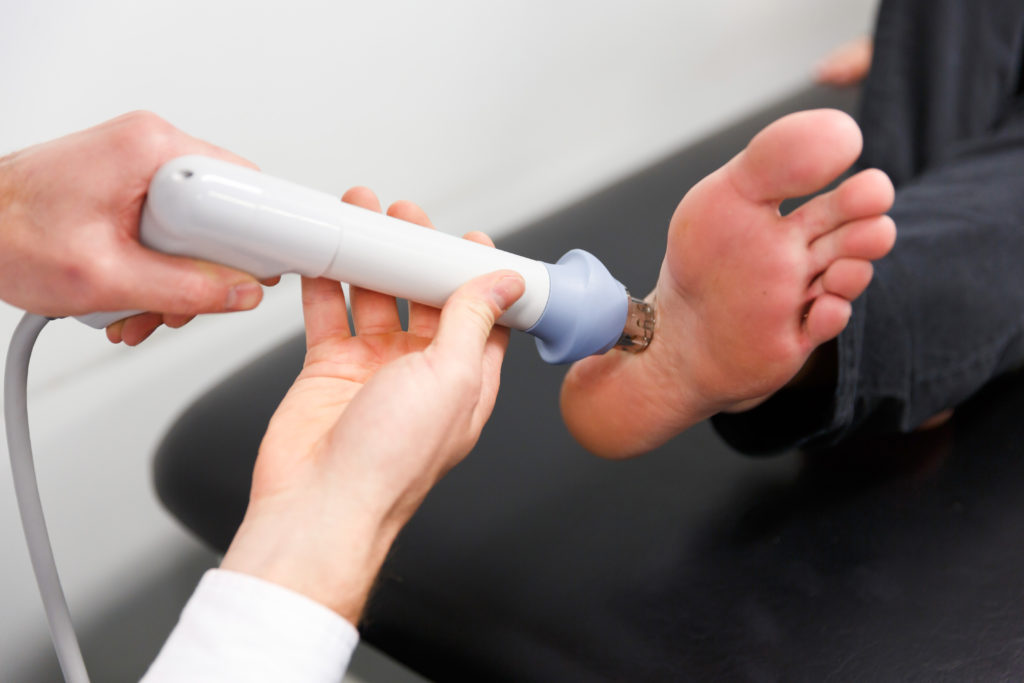

Achilles pain is one of the most common foot problems that our podiatrists see and treat – and it’s no surprise, given the large load placed on the Achilles tendon every time we walk and run, paired with the fact that it has a notably poorer blood supply compared to other tendons around the body.
As a team that embraces and values the role that technology and innovative treatments play in helping our patients achieve superior outcomes for their foot pain and problems, we thought we’d share one key part of some of our patient’s treatment plans that is helping achieve fantastic results in terms of reductions in pain and improvements in foot function: shockwave therapy.
Here’s a look into what shockwave is, the evidence behind its use for Achilles pain, and whether it could be a good option for you, too.
What Is Shockwave?
Referred to as extracorporeal shockwave therapy (ESWT) in the studies (with ‘extracorporeal’ simply meaning ‘situated outside of the body’), shockwave treatment uses a handpiece that is held by your podiatrist and placed against the skin via a gel, to produce high-energy acoustic waves that are transmitted to the area of tendon damage beneath. The acoustic waves then interact with the damaged tissues and cells to produce healing, restorative and pain relieving effects.
Despite its disconcerning name, shockwave is associated with a very tolerable and often minimal level of pain, with many noticing pain-relieving benefits in the minutes and days following the appointment. The time the shockwave is activated on the foot usually spans between 5-15 minutes, depending on the condition being treated and how many treatment sites are needed. What we – and many of our patients – love about the process is that it is completely non-invasive, meaning it doesn’t require injections, anaesthesia or surgery.
To learn more about how shockwave works and other conditions that it can help with, click here.
Shockwave For Achilles Pain: Does It Work?
Aside from the outcomes that we see in patients across our clinics, studies support shockwave therapy as a way to significantly reduce pain so that other interventions, usually exercise, can be implemented to support a healthy recovery. Specifically:
- A review of evidence for shockwave for chronic Achilles tendinopathy found high evidence of efficacy. In this review, randomised placebo controlled trials have confirmed shockwave’s excellent results with regards to function and pain.
- Shockwave has contributed to excellent and good results after both 3 and 12 months for chronic non-insertional Achilles tendinopathy.
- When shockwave is paired with an eccentric loading exercise program, 82% of participants fell into the “completely recovered” or “much improved” categories for their chronic mid-portion Achilles tendinopathy, a higher result than compared to the loading program alone.
- A systematic review on the effectiveness of shockwave on chronic achilles tendinopathy showed that it could produce short-term pain-relieving effects and long-term increased blood flow, both of which improve outcome measures.
- Despite some gaps in the knowledge as published in literature, shockwave therapy is a safe, well-tolerated treatment modality for Achilles tendinopathy.
- The National Institute of Health Care Excellence (NICE) in the UK has declared shockwave to be safe and that it has demonstrated positive results.
With a complex mechanism of action behind shockwave, it is thought to produce its beneficial restorative effects by:
- Stimulating collagen production – collagen is an essential component of repairing certain tissues, so helping produce more helps to optimise the repair process
- Reducing pain – by reducing the concentration of a neurotransmitter called substance P involved in feeling pain
- Promoting new blood vessels to form – blood flow carries oxygen and nutrients, so the more that gets to an injured area, the better for the repair process
- Helping release trigger points in the muscles
- Helping break up calcifications in the tendon fibres which may have previous built up from injury
What Does Shockwave Look Like With Our Podiatrists?
Your feet and your Achilles injury are complex, which is why we never use shockwave as a standalone treatment, but instead as an important part of a comprehensive treatment plan for those who we clinically determine that shockwave is a good option for. This is something that we assess during your biomechanical examination, where we go through your medical and injury history, test the range of motion in your feet and legs, review your muscle strength and foot posture, perform a video gait and pressure analysis, and more.
Your podiatrist will discuss the results of your assessment, and compose a custom treatment plan for your unique circumstances and goals. Alongside shockwave, we may also use a stretching, strengthening and loading program, using supportive footwear, foot mobilisation, custom foot orthotics and more.
Start Treating Your Achilles Pain Today
If you have Achilles pain, our trusted podiatrists are here to help. Book your appointment online by clicking here or call us on 1800 FOOT DR.
References
[1] Gerdesmeyer, L., Mittermayr, R., Fuerst, M., Muderis, M. A., Thiele, R., Saxena, A., & Gollwitzer, H. (2015). Current evidence of extracorporeal shock wave therapy in chronic Achilles tendinopathy. International Journal of Surgery, 24, 154–159. https://doi.org/10.1016/j.ijsu.2015.07.718
[2] Furia, J. P. (2007). High-Energy Extracorporeal shock wave therapy as a treatment for chronic noninsertional achilles tendinopathy. American Journal of Sports Medicine, 36(3), 502–508. https://doi.org/10.1177/0363546507309674
[3] Rompe, J. D., Furia, J. P., & Maffulli, N. (2008). Eccentric Loading versus Eccentric Loading plus Shock-Wave Treatment for Midportion Achilles Tendinopathy. American Journal of Sports Medicine, 37(3), 463–470. https://doi.org/10.1177/0363546508326983
[4] Al-Abbad, H., & Simon, J. V. (2013). The effectiveness of extracorporeal shock wave therapy on chronic Achilles tendinopathy. Foot & Ankle International, 34(1), 33–41. https://doi.org/10.1177/1071100712464354
[5] Stania, M., Juras, G., Chmielewska, D., Polak, A., Kucio, C., & Król, P. (2019). Extracorporeal Shock Wave Therapy for Achilles Tendinopathy. BioMed Research International, 1–13. https://doi.org/10.1155/2019/3086910
[6] West Suffolk NHS Foundation Trust. (2021.). Extra-corporeal Shock Wave Therapy (ESWT) for non-insertional Achilles tendinopathy Inflamed Achilles tendon. https://www.wsh.nhs.uk/CMS-Documents/Patient-leaflets/TraumaandOrthopaedics/6459-1-Extra-corporeal-Shock-Wave-Therapy-ESWT-for-non-insertional-Achilles-tendinopathy.pdf


